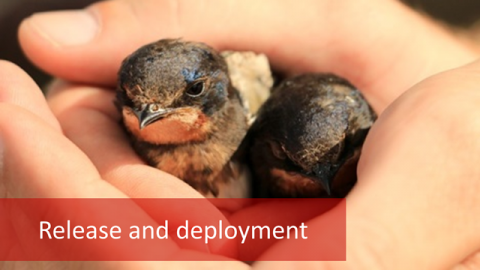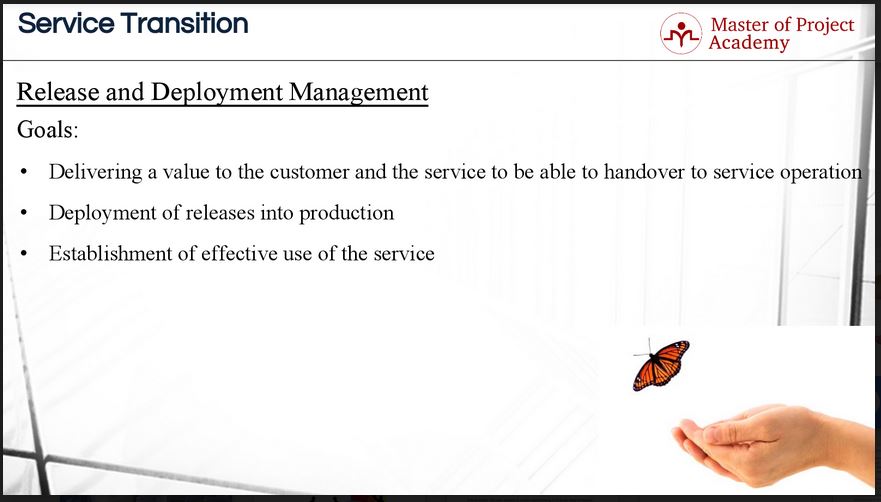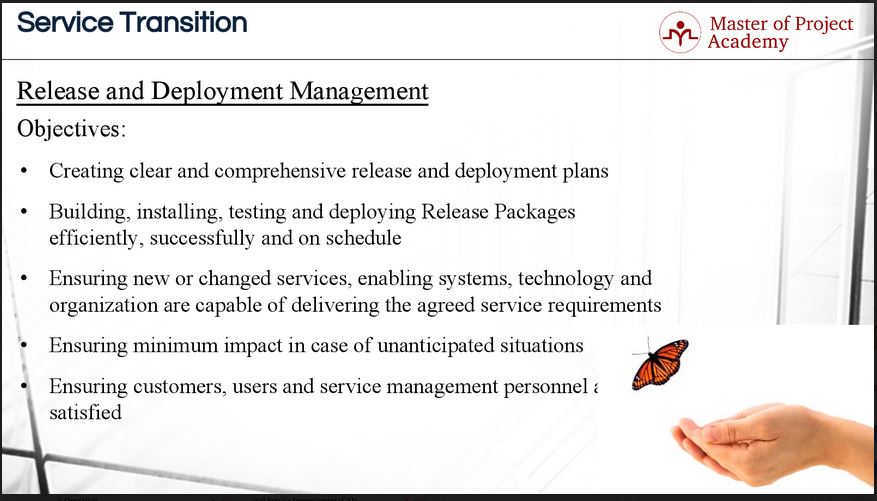The ITIL Service Transition stage of the ITIL lifecycle has several core processes. ITIL training tells us that none are integral to this stage than the release and deployment management process. Without this process, the Service Transition stage would mean nothing. As described in online ITIL courses, the Service Transition stage is the link between ITIL Service Design and ITIL Service Operation. Without the Service Transition stage, and therefore the release and deployment management process, new and upgraded services cannot be successfully deployed and made available to customers.

Planned, designed and built packages are released and deployed under the control of the release and deployment management process. We can say that the release and deployment management process is the core process of the Service Transition stage. The main goal of the Service Transition stage is transferring planned, designed, built and tested packages into service operation stage.
The goals of release and deployment
The main goal of the process is creating value to the customer and the service to be able to be handed over to the service operation. Designed packages at the end of the service design stage are built, implemented and tested in service transition stage and during the release and deployment management process.
Therefore, the deployment of releases into production and the establishment of effective use of the service are the goals of release and deployment management process. After a release package is built, deployed, implemented and tested in Service Transition stage of the ITIL service lifecycle, if there are not any problems during the tests, the release package is deployed into production. Because of this, the release and deployment management process is a critical point to see if there is any problem with the package before deploying the package to production.

The objectives of the release and deployment management
The first objective is creating a clear and comprehensive release and deployment management plans that enable the customer and business change projects to align their activities with these plans. There can be several services, components, applications etc. belonging to an IT service provider. Different requirements of the business or customer can go in parallel projects.
For instance, let’s consider the IT service provider of a bank. There can be customer credit project, ATM project, internet banking project etc. Also, existing services might require fixes due to problems found in production. Since there will be several changes to the services, components, and assets of the IT service provider, these changes must be managed through proper release and deployment management plans to prevent any conflict and outage in production.
The second objective is building, installing, testing and deploying Release Packages efficiently, successfully and on schedule. After the changes to existing services and new services have been designed and prepared, these changes by the IT service provider must be built in combination with each other as a release with other services in the organization as well. There will be relationships of each service with another service, component or application etc. In order to ensure there are not any problems with new services, the built release, including changes to services, is installed and tested before deploying the package into production for the use of the customers. This will reduce the possibility of having a problem in production.

The third objective of release and deployment management is ensuring new or changed services, enabling systems, technology and organization are capable of delivering the agreed service requirements. An IT service provider plans and designs a service in order to meet the service level targets defined in the service level agreement documents between the IT service provider and the business or customer. Before the package is deployed into production, checks to see whether the agreed service level requirements will be met is tested in the release and deployment management process.
The fourth objective of the release and deployment management process is ensuring that there is a minimal unpredicted impact on the production services, operations and support organization. Since the built package is deployed and tested before the package is deployed in a production environment, this will help to see if there are any problems with the package that is built. Therefore, unpredicted impacts on production are minimized with the release and deployment management process.
The fifth and the last objective of the release and deployment management process is ensuring that customers, users, and service management staff are satisfied. The ultimate goal of the service management is meeting and even exceeding the customer expectations and ensuring customer satisfaction in service delivery. The release and deployment management process has this aim as well.
The definition of a release
Until now, we described release and deployment management. You should be aware that the release is a package that aims to deliver services to the end customers based on their requirements.
Let’s look at the definition of release: Release is a collection of hardware, software, documentation, processes or other components, required to implement one or more approved changes to IT services. So the overall service package that includes several interconnected assets with each other to deliver a value to the customer is called a release. The contents of each release are managed, tested and deployed as a single entity. This means that a release includes several services, components, and assets. But these parts of the service package are meaningful only if they are served together to the customer. Therefore a release is managed as a single entity by a service provider.
The release and deployment management process lies at the heart of the Service Transition stage of the ITIL lifecycle. Without the release and deployment management, the Service Transition stage is useless. This process is thus critical to the ITIL service lifecycle.
